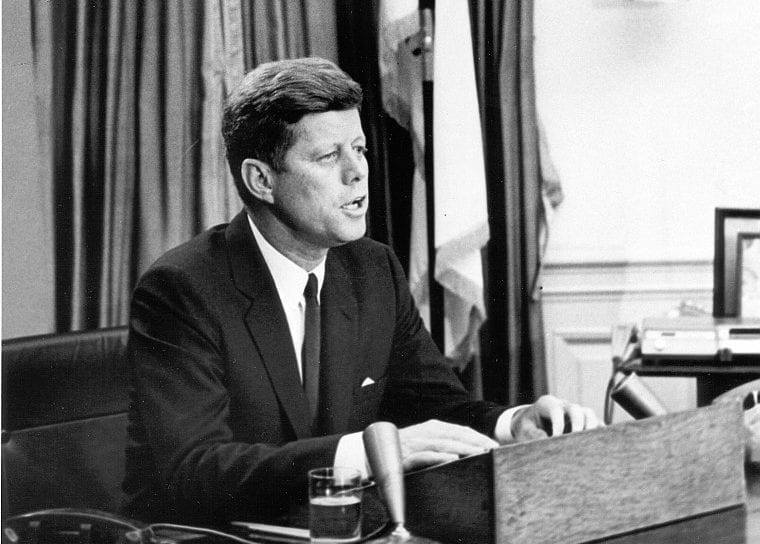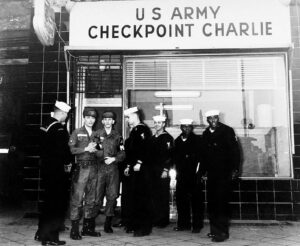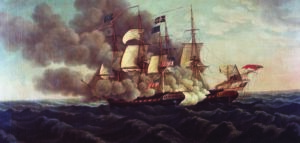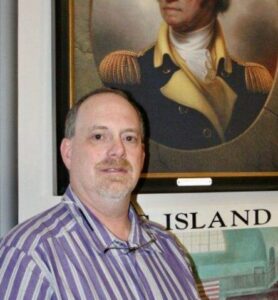
An American-Soviet Face-off in 1961: Tanks in the Streets of Berlin
The images flickering across my television screen seemed too good to be true. It felt like I was watching my favorite college football team win a game that had been going on for nearly fifty years. The game had seemed to be going our way for the last few years. Now our team had broken the stalemate and gained momentum. Finally, an unexpected concession: the East German “coach” of the opponents accepted defeat. There would be no last second field goal or Hail Mary miracle. The west had won!
Images of people climbing over the barricades and storming into West Berlin were like college kids celebrating a long-hoped-for victory over their bitter rival. Like fans attacking a goal post, other celebrants, using hammers and chisels, assaulted “The Wall” that had blocked them from the West for decades. It was November 9, 1989, and the Berlin Wall was coming down.
Why was the wall built? Soviet Premier Nikita Khrushchev said West Berlin “stuck like a bone in the Soviet throat.” The Soviets resented the division of Berlin, which sat entirely in the East German sector under their control and purview. As East Berliners grew increasingly envious of the prosperity building in West Berlin and West Germany, an epic “brain drain” began. Thousands of East Germans fled to the West via easy access to West Berlin. Indeed, over fifty thousand East Germans fled between June of 1961 and August 13, the day construction began. It took about two weeks for East German forces, working with volunteer construction workers to complete a temporary enclosure. Construction continued over the years until a permanent wall was completed.
Even now, over twenty years after the event, I struggle to believe that I lived to see the Berlin Wall destroyed. For many Americans, myself included, the Cold War rivalry in the post-WWII era between the world’s two most powerful nations, the United States and the USSR, had achieved permanent status in our minds. We assumed the inevitability implied in William Faulkner’s suggestion that the central question of our time was “When will I be blown up?” The Berlin Wall was the most tangible symbol of a military and political rivalry that, for the first time in human history, threatened humanity’s very existence.
Much of the Cold War tension between the two superpowers focused on Central Europe. Defeated Germany was divided into four sectors in 1945, with each sector controlled by a victorious ally, the US, USSR, France, and the United Kingdom. East Germany was in the USSR zone, and Berlin, entirely within the borders of East Germany, was similarly divided.
In August of 1961, Americans learned that the East Germans and their Soviet allies had installed a wall encircling Berlin and separating East Berlin from West Berlin almost overnight. They worried that Berlin, already the headquarters for the aggressor in two twentieth-century world wars, could become Ground Zero for World War III.
In 1962, the focus shifted to the western hemisphere. Americans anxiously watched President John Kennedy announce “a quarantine” of Cuba when the Soviets attempted to install a nuclear weapons base in the island, which lies only ninety miles from the Florida coast. And they saw their children practice duck and cover drills in school – an exercise exceeded in its silliness only by its futility.
The Cuban Missile Crisis of October 1962 is considered to mark the moment when the United States and the USSR came closest to engaging in direct combat. The stakes were enormous. President Kennedy could not allow the Soviets to install a nuclear base in Cuba, and Soviet Premier Kruschev could not afford to blink in a confrontation with an American president he viewed as weak and unprepared. The high-seas drama ended peacefully when the Soviets agreed to withdraw their weapons from Cuba in exchange for an overt American promise not to invade Cuba and a secret promise to remove its Jupiter missiles from Turkey.
One year before the Cuban Crisis, in October of 1961, another stand-off between the Americans and the Soviets occurred in Europe. That fall, ten Soviet tanks and ten American tanks separated by a hundred yards staged a tense sixteen-hour face-off in the streets of Berlin.

The October crisis of 1961, triggered by an American diplomat’s plans to attend the opera in East Berlin, had its roots in the ambiguity surrounding access to the Russian sector. In 1945, the allies agreed that military and diplomatic personnel could travel freely from sector to sector in occupied Germany. They did not specify whether each occupying force was entitled to verify the identity of another occupying force’s personnel when they entered their sector.
On October 22, 1961, US diplomat Allan Lightner attempted to pass through Checkpoint Charlie – the access point designated for foreigners and allied personnel. He was asked for his passport and refused to comply. A dispute over a simple bureaucratic procedure escalated into a full-blown diplomatic crisis. Five days after Lightner failed to make the opera, ten Soviet tanks arrived at Checkpoint Charlie, aiming their guns toward the West. American tanks arrived on the scene shortly thereafter. The stand-off continued for sixteen hours before the two sides reached a withdrawal agreement. In the words of Henry Kissinger in his book Diplomacy, the US was not “going to war over who stamps a transit document or whether to recognize” the East German government.
It is interesting to speculate why the stand-off in October 1961 receives far less attention from teachers and students of American history than the Cuban Missile Crisis of 1962. Both the similarities and differences are striking. Both crises occurred in October – perhaps mere coincidence – and both involved US and USSR military forces. Both might have turned the Cold War hot – leading to war between the US and USSR. Given that both superpowers had nuclear weapons, the possibility of a nuclear exchange with catastrophic casualties seems plausible.
In the 1962 crisis, one American pilot was shot down and killed over Cuba. Yet, both situations resulted in mostly peaceful outcomes. The tanks withdrew from Checkpoint Charlie in 1961, and the Soviet merchant ships and submarine escorts turned back from the US Navy’s quarantine line in 1962 before delivering nuclear weapons components to Cuba. President Kennedy and Premier Khrushchev celebrated face-saving gestures in the diplomatic war of words.
Perhaps a good lesson for high school American history students would be to analyze the differences between the two events by addressing intriguing questions about them. Why did Premier Khrushchev take the risk of putting nuclear weapons in Cuba? Why did President Kennedy draw a line in the sand in 1962 but not 1961? Did his decision in 1961 embolden Khrushchev and contribute to the crisis of 1962? What role did the US claim to a sphere of influence in the Western Hemisphere, based on the Monroe Doctrine and Roosevelt’s corollary to it, play in President Kennedy’s decisions? Did Premier Khrushchev’s view of President Kennedy play a role in Soviet actions? What role did the Bay of Pigs fiasco early in the Kennedy administration play in the Cuban Missile Crisis? How did the United States view Cuba and Berlin after the October crises of 1961 and ’62?
Teachers may consider assigning one or more of the following primary source documents from the Teaching American History website to help students reach their conclusions.



